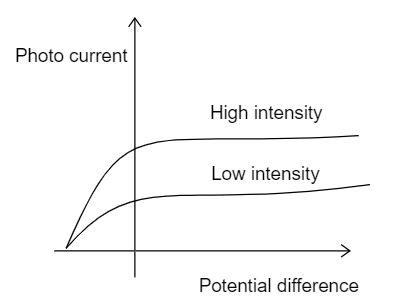
Draw the graphs showing variation of the photoelectric current with applied voltage for two incident radiations equal frequency and different intensities. Mark the graph for radiation of higher intensity.
Answer
216.6k+ views
Hint: In the process of photoelectric effect, the electrons from the metal surface are made to emit with the use of the light radiations which incident on it. These electrons are used as the current and it is known as photo electric current.
Complete step by step solution:
The radiation incident on the metal surface influences the output photo current of the metal. The suitable radiation produces the photo current which is directly proportional to the intensity of the radiation that incident on the surface of the metal. Intensity is defined as the power of the incident light that falls on the metal surface. The frequency is the number of times the repeated event occurs over a given time. The below graph represents the variation of the photocurrent of the two equal voltages with the same frequency but the different intensities.

Hence the graph shows that the radiations of the same frequency but the different intensity may produce the different photocurrent from the metal. Hence the intensity of the radiation has the most influence in the production of the photocurrent.
Note: The point at which the photocurrent is maximum, it is called as the saturation current and point in which the photo current becomes zero, it is called as the cut- off voltage. The cut- off voltage is also called stopping potential.
Complete step by step solution:
The radiation incident on the metal surface influences the output photo current of the metal. The suitable radiation produces the photo current which is directly proportional to the intensity of the radiation that incident on the surface of the metal. Intensity is defined as the power of the incident light that falls on the metal surface. The frequency is the number of times the repeated event occurs over a given time. The below graph represents the variation of the photocurrent of the two equal voltages with the same frequency but the different intensities.

Hence the graph shows that the radiations of the same frequency but the different intensity may produce the different photocurrent from the metal. Hence the intensity of the radiation has the most influence in the production of the photocurrent.
Note: The point at which the photocurrent is maximum, it is called as the saturation current and point in which the photo current becomes zero, it is called as the cut- off voltage. The cut- off voltage is also called stopping potential.
Recently Updated Pages
Wheatstone Bridge Explained: Working, Formula & Uses

Young’s Double Slit Experiment Derivation Explained

JEE Atomic Structure and Chemical Bonding important Concepts and Tips

JEE Amino Acids and Peptides Important Concepts and Tips for Exam Preparation

Electricity and Magnetism Explained: Key Concepts & Applications

Chemical Properties of Hydrogen - Important Concepts for JEE Exam Preparation

Trending doubts
JEE Main 2026: Application Form Open, Exam Dates, Syllabus, Eligibility & Question Papers

Derivation of Equation of Trajectory Explained for Students

Hybridisation in Chemistry – Concept, Types & Applications

Understanding the Angle of Deviation in a Prism

Understanding Collisions: Types and Examples for Students

How to Convert a Galvanometer into an Ammeter or Voltmeter

Other Pages
JEE Advanced Marks vs Ranks 2025: Understanding Category-wise Qualifying Marks and Previous Year Cut-offs

Understanding Atomic Structure for Beginners

Ideal and Non-Ideal Solutions Explained for Class 12 Chemistry

Degree of Dissociation: Meaning, Formula, Calculation & Uses

Understanding Electromagnetic Waves and Their Importance

Understanding the Electric Field of a Uniformly Charged Ring




